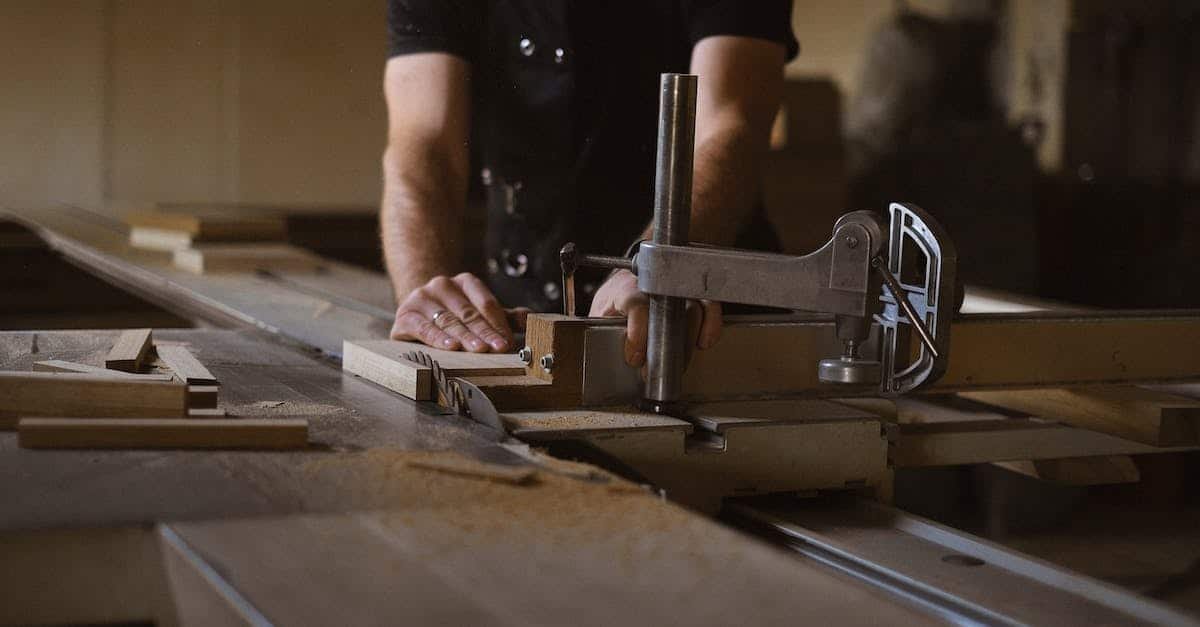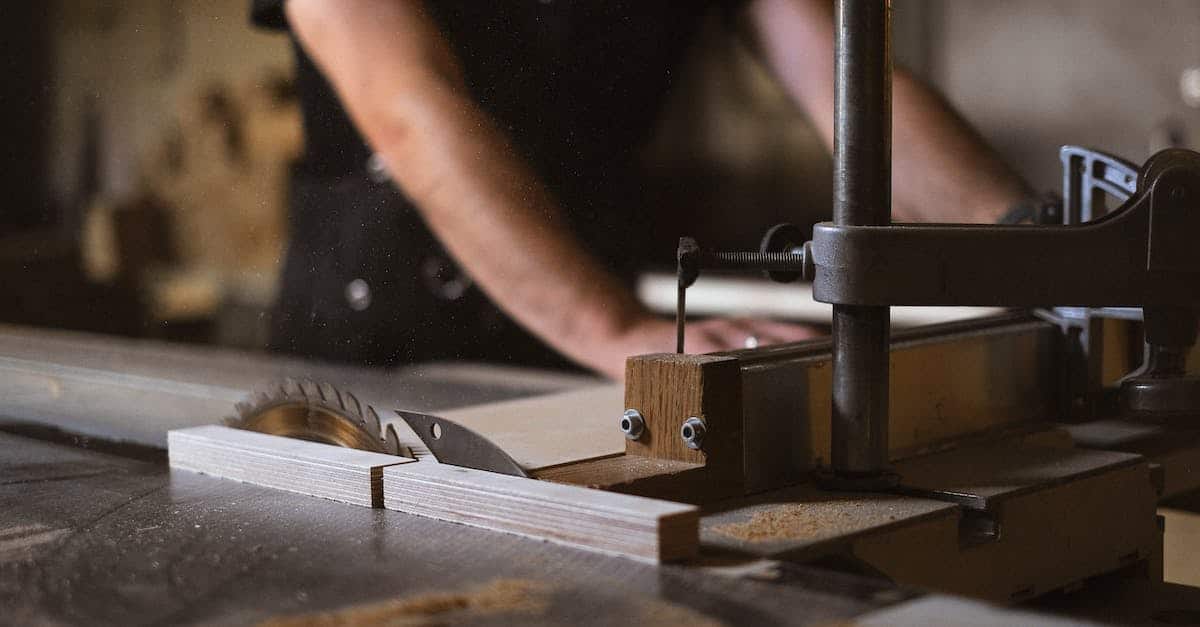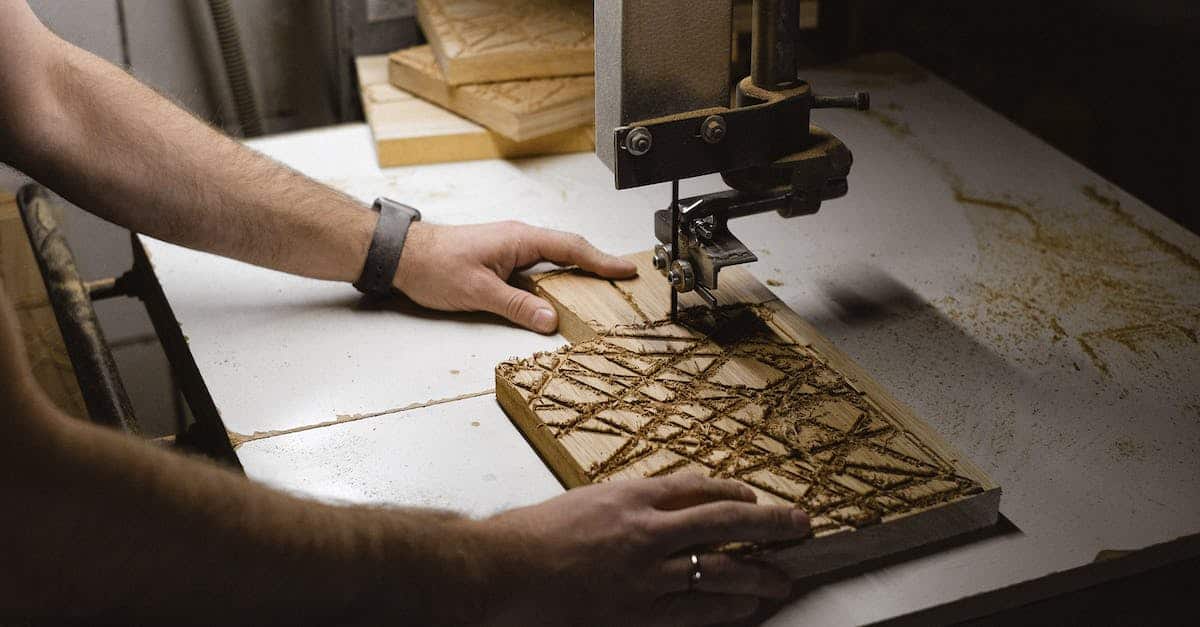You know the satisfaction of a job well done, especially when it involves the art of woodworking. But let’s not forget that your tools are your trusted partners in this craft. Keeping them clean not only ensures precision in your work but also extends their life.
In this article, you’ll discover the best practices for cleaning your woodworking tools, from chisels to table saws. Whether you’re a seasoned woodworker or just starting out, these tips will keep your tools in top shape and your projects looking sharp.
Why Cleaning Woodworking Tools is Important
When you head out to your garage to create something from a simple piece of wood, you’re using tools that become an extension of your craft. Keeping them clean isn’t just about aesthetics; it impacts everything from the quality of your work to the life expectancy of your tools.
Imagine you’re halfway through a project, and a dirty saw blade burns the wood or a chisel with built-up sap alters the precision of your cuts. It’s frustrating, right? Such setbacks are common when tools are neglected. Regular cleaning removes residues that can cause damage to both your materials and the tools themselves.
Your tools’ longevity is directly tied to how well you maintain them. Rust, corrosion, and build-up can all drastically shorten the useful life of your cherished equipment. As a woodworker, you’ve likely invested a significant amount in your tools, so it makes sense to protect that investment.
Moreover, the safety of your DIY endeavors hinges on tool maintenance. A clean blade is predictable and less likely to bind or kick back, thus reducing the risk of accidents. Your well-being is paramount, and by keeping everything in top condition, you’re safeguarding more than just your work; you’re protecting yourself.
Finally, there’s the matter of efficiency. Clean tools mean clean cuts and joins, which lead to better fits and less time spent sanding or correcting mistakes. Your workflow improves, and you’ll find that projects that once felt laborious now move along at a brisk, more enjoyable pace.
Remember, a clean workspace, which includes well-maintained tools, reflects the pride you take in your craft. As you become more proficient in cleaning and caring for your tools, you’ll notice an undeniable improvement in all areas of your woodworking projects.
Essential Tools for Cleaning Woodworking Instruments
When it comes to keeping your woodworking tools in top shape, having the right cleaning tools is as crucial as knowing the correct techniques. Precision and care in choosing your cleaning implements ensures that you’ll tackle every bit of sawdust and resin, safeguarding your tools for years of use.
First up, you’ll need a set of nylon brushes. These versatile brushes are tough on dirt but gentle on your tools’ surfaces. You’ll want a range of sizes to get into all the nooks and crannies—especially crucial for intricate router bits and complex blade geometries.
Cleaning solvents play a pivotal role in dissolving stubborn sap and resin. Opt for a solvent that’s designed for woodworking tools to avoid corrosion or damage. Remember to use them in a well-ventilated area and always follow the manufacturer’s instructions for safety.
Don’t overlook the importance of microfiber cloths. These cloths are perfect for wiping down tools after a cleaning session, ensuring no residue is left behind. They’re soft, non-abrasive, and won’t leave any lint—a must for a pristine finish.
And what about those pesky wood chips that cling to bandsaw blades and drill bits? A brass brush is your friend here. Brass is softer than steel, so it won’t scratch your tools but still has the strength to remove any clinging debris.
Lastly, keep a can of compressed air on hand, essential for blowing dust out of tight spaces where cloths and brushes can’t reach. It’s particularly useful for cleaning out air filters, motors, and detailed workpieces.
Equipping your workshop with these cleaning essentials will ensure that you’ll not only maintain the functionality and safety of your tools but also extend their lifespan significantly. Remember—taking the time to carefully clean each tool after use reflects your dedication to the craft and pays off in the smoother operation and better results of your woodworking projects.
Step-by-Step Guide to Cleaning Chisels
Chisels are your woodworking lifelines, vital for precise cuts and shaping wood to perfection. Keeping them squeaky clean not only preserves their sharpness but also your craftsmanship. Let’s roll up our sleeves and get those chisels looking brand new.
Start With the Handle
Grab your nylon brush and gently sweep away any loose debris from the handle. Wood chips and dust have a sneaky way of clinging on but don’t stand a chance against a good brush-down. If you spot any stubborn gunk, a damp microfiber cloth should do the trick. Remember to immediately dry the handle with a clean cloth to prevent any water damage.
Clearing the Blade
The blade requires a bit more TLC, and here’s where your brass brush comes into play. Carefully scrub off any sap or resin—these residues are the archenemies of a clean cut. For any lingering grimness, use a cleaning solvent specifically designed for metal tools. Apply it with a microfiber cloth in gentle circular motions to lift any oxidation without damaging the blade.
- Apply solvent sparingly
- Avoid harsh scrubbing
- Opt for non-abrasive cloths
The Final Touch
After the solvent has worked its magic, it’s time for a blast from your compressed air canister. Hold it at a considerable distance to avoid condensation buildup on the metal. Follow up with another pass of a clean microfiber cloth to ensure everything is truly spotless.
| Maintenance Task | Tool Required | Action Suggested |
|---|---|---|
| Handle Debris Removal | Nylon Brush | Sweep gently |
| Stubborn Gunk Removal | Microfiber Cloth | Damp wipe followed by dry cloth |
| Blade Sap and Resin Removal | Brass Brush | Scrub carefully |
| Blade Cleaning and Polishing | Cleaning Solvent | Apply with cloth in circular motions |
| Drying and Final Dust Removal | Compressed Air | Blast from a distance, then wipe |
Your chisels are now set for your next woodworking adventure, prepared to carve, cut, and chisel their way through anything you envision. Keep them in this pristine condition and they’ll be your trusty partners for many projects to come.
Cleaning Techniques for Saws
As you delve into the world of woodworking, you’ll quickly note that saws are among your most valued companions. Whether it’s crosscutting a plank or ripping through hardwood, your saws take a beating. That’s why cleaning and maintaining them is key to ensuring they cut cleanly and efficiently every time.
When cleaning your saw blades, start by removing them from the saw if possible. Lay them flat on a secure surface to prevent any bending or warping. If you’re dealing with a handsaw, secure it in a vise, making sure not to overtighten and damage the blade.
Once secure, mix a solution of warm water and mild detergent in a bucket. Always wear gloves to protect your hands. Dip a scrub brush into the solution and gently scrub the blade’s teeth. For stubborn areas, you might consider a specially designed pitch and resin remover but be sure to follow the manufacturer’s instructions to avoid damaging the blade.
After cleaning with the solution, rinse the saw blade with clean water. Immediately dry the blade to prevent rust. A quick wipe with a dry cloth should do the trick, but for an extra layer of protection spray the blade with a light coat of lubricant. This not only wards off rust but also helps the saw cut more smoothly the next time you use it.
If you notice any rust spots that have taken hold, don’t panic. A bit of sandpaper or steel wool, rubbed carefully along the affected area, can clear it right up. Finish by wiping the blade down with a light machine oil or WD-40 to keep rust at bay.
Remember, some saws require additional care, such as those with carbide-tipped blades. Be sure to refer to the tool’s manual for specific care instructions that cater to the unique needs of these blades. With regular cleaning, your saws will stay sharp, dependable, and ready to handle your next woodworking inspiration.
Maintaining Hand Planes for Optimum Performance
Hand planes are an extension of your woodworking expertise. When they’re neglected, it doesn’t just reflect on the tool’s condition but also on the quality of your work. Like any longtime woodworker, you’ll know these are the bedrock of a well-used toolkit.
Start by wiping off any obvious sawdust or debris. It’s the simplest step but often overlooked. This prevents particles from scratching the surface or dulling your plane’s blade. Next, focus on the blade itself. It should be as sharp as your skills, and there’s no cutting corners here. You’ll need to remove the blade and use a whetstone or honing guide to get that edge just right.
Once the blade gleams with readiness, pivot your attention to the plane’s body. You’re aiming for smooth sailing, or in this case, planing. Use fine grit sandpaper to buff out any surface rust or imperfections. Remember, a smooth body allows for less resistance when you’re working.
Lubrication isn’t just about making things slick; it’s about protection and efficiency. Lightly oil the moving parts to ensure they move freely without any gunk build-up. This is especially important if you’re storing your tools for an extended period.
Always inspect the sole of the plane – it must be flat. Any warping or dents can render your planing efforts less accurate, affecting the outcome of a project. If necessary, employ a file or sandpaper to correct any irregularities.
The adjustment mechanisms are the unsung heroes, providing control over your plane’s performance. Carefully clean and adjust the parts that set the depth and alignment of the blade.
Finally, although your hand plane doesn’t have a motor, it still benefits from periodic checks. Make sure screws and fasteners are secure because a loose plane is as good as none. Regular care will keep these essential tools in top shape and your craft at its peak.
Tips for Cleaning Power Tools
Maintaining your power tools is just as crucial as caring for your hand tools. Dust and debris are the main culprits when it comes to tool wear and tear, potentially leading to damage or a decrease in performance. Here’s how to keep your power tools in the best shape possible without much hassle.
Unplug and Disassemble
Safety’s always first, so ensure that you unplug any power tool before you start cleaning. You’ll want to remove any attachments or bits and carefully disassemble parts that collect the most debris. This includes guards, blades, or anything that’s designed to be removed for maintenance.
Blow Out Debris
Your best friend for this job is compressed air. A good blast can get rid of sawdust from inner workings that a cloth just can’t reach. Be thorough, but gentle; too strong a force can damage delicate components.
Wipe Down Surfaces
After you’ve cleared the debris, use a clean, dry cloth to wipe down all surfaces. For stubborn spots, lightly dampen the cloth with water or a cleaner specifically designed for your tool’s material. Steering clear of harsh chemicals will prevent damage to any rubber grips or plastic parts.
Lubricate Moving Parts
Just like with hand tools, power tools need their moving parts to be well-lubricated. Apply oil or a silicone-based lubricant sparingly to any parts that make contact with each other during operation. Remember, a little goes a long way and avoids attracting more dust.
Inspect and Reassemble
Before putting your tool back together, take a moment to inspect all parts for wear or damage. Replace anything that looks questionable to prevent mishaps down the line. Once you’re satisfied, reassemble with care, double-checking each step.
Regularly cleaning your power tools not only extends their lifetime but also ensures they’re ready for action whenever you set foot into your workshop. With clean tools in hand, your woodworking projects will not just be a labor of love, but also a testament to your diligence and care for your craft. Keep up with these maintenance routines, and you’ll enjoy precision and safety on every project you undertake.
Best Practices for Storing Cleaned Woodworking Tools
After you’ve cleaned your woodworking tools, storing them properly is the next critical step to ensure they stay in top-notch condition. It’s not just about keeping your garage or workshop tidy; it’s about protecting your investment and making sure your tools are always ready when you are.
Dry Is the Way to Go
Moisture is your woodworking tools’ worst enemy. Before you put them away, make sure they’re completely dry. Humidity can cause rust and degradation, shortening your tools’ lifespan. Store your tools in a dry place with stable temperature and humidity levels.
Choose the Right Storage Units
- Tool Cabinets: Lockable tool cabinets with drawers lined with a protective material are perfect for small to medium-sized tools. They keep dust and moisture out and also discourage any unauthorized use.
- Wall Racks: For easy accessibility, hang your larger tools on wall-mounted racks or magnetic strips. This also serves to keep sharp edges and points safely out of the way.
- Mobile Bases: If you’re short on space, placing tools on mobile bases allows you to move heavier equipment easily. This gives you the flexibility to rearrange your workspace as needed.
Organize with Care
Organization is key to a functional workshop. Keep tools that work together close to each other; for example, store your chisels near your mallets. It’s not just about convenience; it’s about efficiency too.
Frequent Maintenance Checks
Even when not in use, check your tools periodically. Look for signs of rust, corrosion, or other damage. Early detection can save you time and money in the long run.
Remember, the time and effort you put into cleaning and storing your woodworking tools reflect in the quality and precision of your work. Treat them with care, and they’ll serve you well for years to come.
Conclusion
Taking care of your woodworking tools doesn’t just preserve their lifespan—it’s a reflection of your craftsmanship. By keeping them clean and well-organized, you’ll ensure they’re ready when inspiration strikes. Remember, a little effort after each use goes a long way in maintaining the precision needed for your projects. So tuck your tools into their proper places and rest easy knowing they’re prepped for your next creative endeavor. Happy woodworking!
Frequently Asked Questions
What is the best way to clean woodworking power tools?
To clean woodworking power tools, remove any debris with a brush or compressed air. Wipe down surfaces with a damp cloth and mild detergent if necessary. Make sure they’re completely dry before storing to prevent rust and damage.
How do I ensure my woodworking tools don’t rust during storage?
Ensure your woodworking tools are entirely dry before storage. Use a rust inhibitor or a protective coating on metal surfaces. Store them in a dry environment and consider using desiccants or dehumidifiers if humidity is a concern.
What type of storage should I use for my woodworking tools?
Choose storage options like tool cabinets, wall racks, or mobile bases. Consider factors like space, ease of access, and protection from the elements when selecting the right storage for your woodworking tools.
How often should I organize my woodworking tools?
Organize your tools as often as needed to maintain convenience and efficiency. Regular check-ups and reorganization can prevent clutter and ensure tools are always ready for use.
Why is frequent maintenance checks important for woodworking tools?
Frequent maintenance checks are crucial to identify and address any wear or damage early on. This proactive approach helps extend the life of your tools and ensures they perform at their best for precise and high-quality work.




